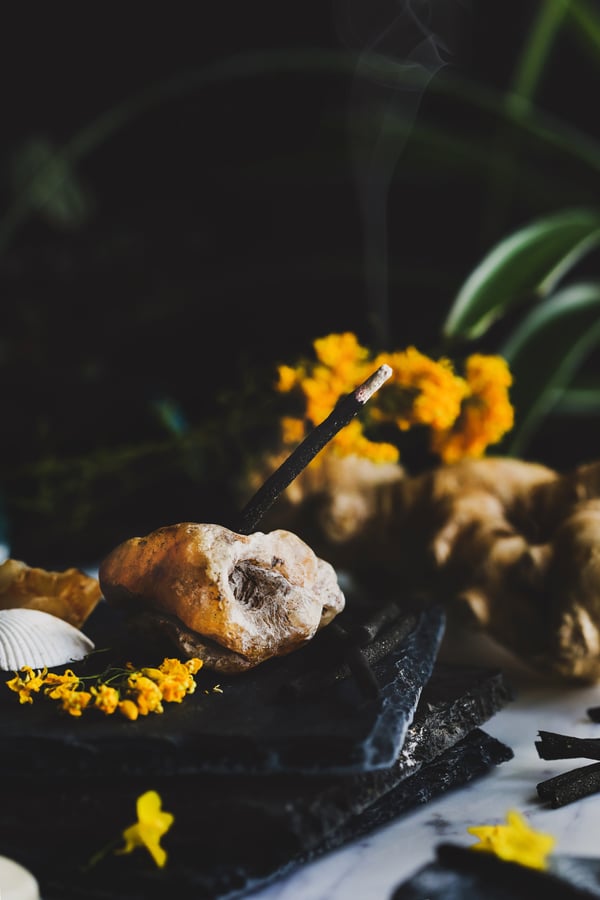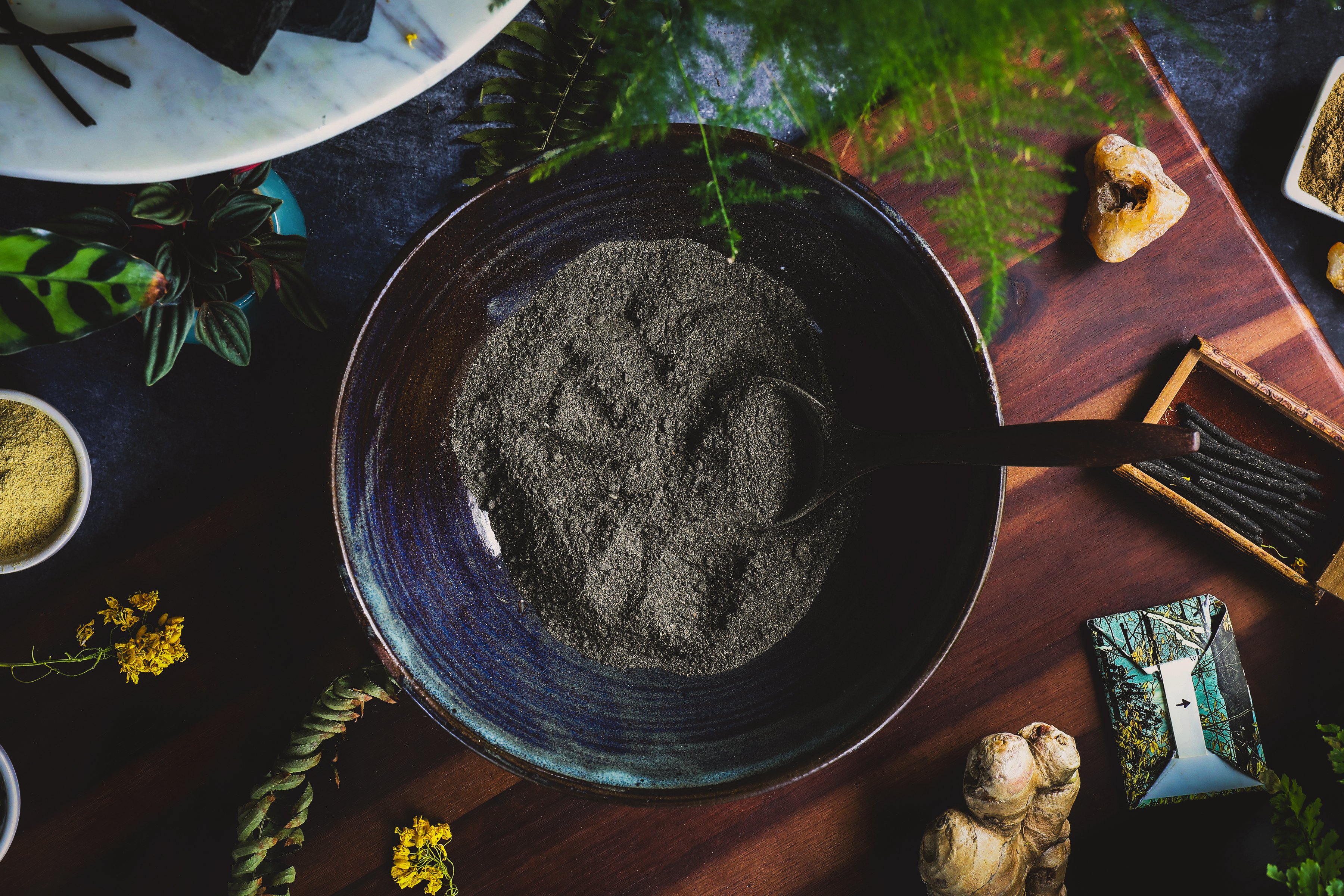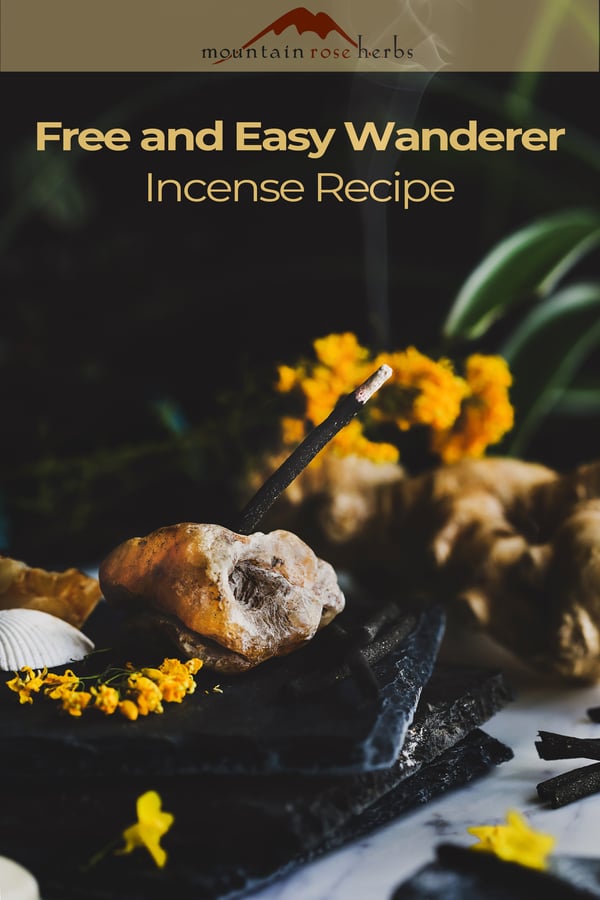I love small rituals. Having lived out of a backpack for most of my twenties and still traveling a lot in my thirties, small yet potent packages of transportable sweetness help me create a sense of belonging no matter where I land. On most adventures, I commune with the landscape of my inner and outer terrain with my traveling trifecta of tea, journal, and incense.
Jump to Recipe
Why Burn Incense?
Fire’s glow sparks magic, invites presence, transforms energy, and connects communities. Incense has a long history of creating sacred space, uplifting intentions, and communicating between realms. By heating plants and resins, we release volatile phytoconstituents that purify both physical and spiritual dimensions for ceremonial, medicinal, and home uses.
Making our own incense provides a tactile connection with the land, medicine, and our bioregional terroir. Mixing and shaping incense by hand, we reconnect with our indigenous roots of shaping the earth, building rituals, and serenading our ancestors with songs carried on spiraling smoke.
East Asian Medicine and Incense
We find records of medicinal incense from the early Han dynasty in China, over 2000 years ago, with uses listed for everything from purifying rooms to treating headaches. Non-medicinal incense lent its aroma to religious ceremonies, perfuming clothing, and delighting the senses. Aromatic botanicals often include xiang (香) in their names, meaning “scent.” This includes agarwood (chen xiang 沈香), sandalwood (tan xiang 檀香), frankincense (ru xiang 乳香), and cloves (ding xiang 定香). Some Traditional Chinese Medicine formulas create lovely incenses for both medicinal and recreational uses, such as Yue Ju Wan (越鞠丸), Chuan Xiong Cha Tiao San (川芎茶調散), and the star of today’s show, Xiao Yao San (逍遙散) or “Free and Easy Wanderer.”
Free and Easy Wanderer
The growth, potential, and dynamism of spring ushers fast changes into our worlds and bodies. During spring, the Yellow Emperor’s Classic of Chinese Medicine (Huang Di Nei Jing 黃帝內經) counsels us to let down our hair and take long walks in the garden, to give our energy, or qi (氣), room to flow freely. With enthusiastic spring qi surging within and around us, we must cultivate healthy practices to let the rising sap of energy move.
Free and Easy Wanderer formula can help unclench stagnated qi, restoring the river of qi to its natural unrestricted flow with deep breaths and a free and easy body, mind, and life.
The internal use of this formula is not for everyone. Please consult a qualified East Asian medicine practitioner to customize formulas for you. However, as an incense, Free and Easy Wanderer is safe and enjoyable. Aromatic, gentle, uplifting, and relaxing, enjoy Free and Easy Wanderer incense while sitting by your favorite tree or stream with a yummy tea, calming your mind and nourishing your senses.
A Note About Makko: Incense requires a base, binder, aromatics, and water. Bases burn well and evenly. Binders and water weave the incense together like a glue. Aromatics lend incense their scent. Makko serves a double purpose as both a base and binder, and so is commonly used in making incense. Charcoal supports makko as a base, and can act as a base substitute. Binder substitutes can include marshmallow root or guar gum. For potential makko substitutes, include 40% of marshmallow root, or 1/8 tsp of guar gum per 2 tablespoons of incense (1:48 ratio).
Free and Easy Wanderer Incense Recipe
Makes about 50 sticks.
Ingredients
Powders
- 5 g organic bupleurum root (柴胡 chai hu. Bupleurum chinense, Apiaceae)
- 5 g organic dong quai root (當歸 dang gui. Angelica sinensis, Apiaceae)
- 5 g organic atractylodes root (白朮 bai zhu. Atractylodes macrocephala, Asteraceae)
- 3 g organic white peony root (白芍 bai shao. Paeonia lactiflora, Paeoniaceae)
- 2 g organic licorice root (甘草 gan cao. Glycyrrhiza glabra, Fabaceae)
- 16 g organic makko powder (抹香 mo xiang. Machilus thunbergii, Lauraceae)
- 2 g Charcoal powder
Decoction
- 1 Tbsp. fresh or dried organic ginger rhizome (乾薑 gan jiang. Zingiber officinalis, Zingiberaceae)
- 1 Tbsp. organic peppermint leaves (薄荷 bo he. Mentha piperita, Lamiaceae)
Directions
- Powderize herbs with a blender or other tool and sift into a bowl until you have a very fine powder.
- Mix all powders evenly.
- Decoct ginger in 2 cups of water on low heat for 10 minutes. Turn off heat, then add mint.
- Steep covered for 5 minutes. Strain, and let cool.
- Slowly add cooled decoction to powders with a pipette or small spoon.
- Mix until dough is moist enough to hold together, but not too wet or sticky.
- Gently roll dough into thin incense sticks by rolling between your hands, wooden boards, or with an extruder.
- Cut to 2-inch-long 2-mm-diameter lengths.
- Pack incense sticks tight and straight to dry, ideally on a plastic or metal screen or frame that allows for free airflow.
- Let dry for 2-7 days.
Pro Tips
- I modified the original Xiao Yao San (Free and Easy Wanderer) formula to create incense by removing Poria fungus (茯苓 fu ling. Poria cocos, Polyporaceae). Poria is important in imbibing the formula, but less important for incense, since it is less aromatic.
- If you cannot find an ingredient, then simply increase other aromatic ingredients, such as bupleurum or dong quai. You can also modify with other aromatic botanicals and create your own blends. The ratios in this formula are 5 parts botanical powders, to 4 parts makko, to 1 part charcoal.
How to Burn and Store Incense
Light your incense on metal, ceramic, stones, shells, or soil. Store in paper, metal, or glass. Create a “handmade corner” in your home, a peaceful ritual space for silence, solace, and intentional storage and usage of handmade goods. Your incense can live here.
Traveling With Incense & Small rituals
Create a traveling incense box from upcycled matchboxes or mint tins. Consider adding:
- Matches or lighter
- Small incense holder
- Other aromatic incense plants, such as sages, cedar, or palo santo
- A meaningful poem or picture
Walk, bike, or drive to a special spot outdoors. Bring a little tea, incense, and perhaps some poetry. Laozi's “Dao De Jing” (老子道德經) is perfect. Sit solo, or with a friend. Watch the landscape, sip tea, and take in the aromas of the incense. Meditate on dancing smoke, commune with your ancestors and the spirits of the land, and wiggle your toes. Feed your free and easy wanderer self with beauty and breathe.
LOOKING FOR MORE FROM JILING?
Read Her Other Seasonally-Inspired TCM posts!
You might also enjoy:
- What is Opoponax & How to Use It
- The Art & Science of Blending Essential Oils
- Yoga Mat Cleaner Spray
References
● Lorraine, Wilcox. "Medicine-Making Medicinal Incense." Class lecture at Alhambra Medical University, Alhambra, CA, 2018.













